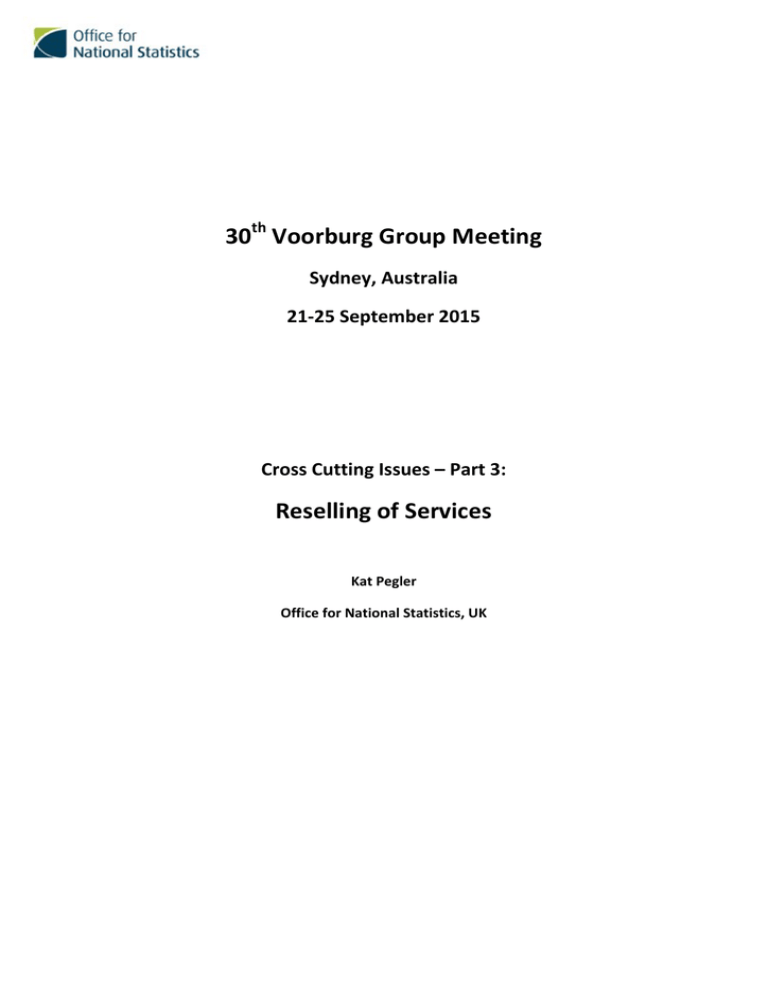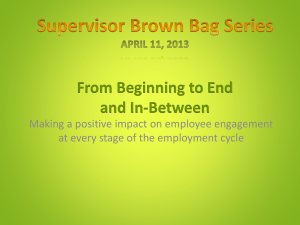30 Voorburg Group Meeting Reselling of Services
advertisement

30th Voorburg Group Meeting Sydney, Australia 21‐25 September 2015 Cross Cutting Issues – Part 3: Reselling of Services Kat Pegler Office for National Statistics, UK 1. Introduction This paper aims to set out the UK views on the re‐selling of services, the key problems that we have experienced and suggested methods for addressing these problems. Generally, we have addressed the re‐selling of services on an industry‐by‐industry basis and while considering the collection of turnover and prices independently. As a result, this paper represents our first attempt to bring the common themes together for the Service Sector. 2. Definition The IMF PPI manual recommends that PPIs measure actual transaction prices reflecting revenue received by the producer for products sold to customers. Where services are resold, the transaction doesn’t occur directly between the producer and the final customer, since an intermediary purchases the service to re‐sell to consumer. There are two models by which the re‐sale of services can occur: Agent – this is where the intermediary procures a service on behalf of a client. The service provided by the agent can usually be clearly defined and the fee charged for this can be identified. For example, a real estate agent may source a property available for rental on behalf of a client. The service provided by the agent is to bring the property owner and the client together and the agent often charges a percentage fee of the property rental value for this service. Outsourcing – this is where the intermediary procures the service and re‐sells it as part of a broader service product. For example, an airline may outsource its baggage handlers, but sells a complete air transport service to the consumer. In this model, it is often difficult to define the service provided, and the associated prices, of each company. Figure 1. Illustration of agent and outsourcing models Service provider £ £ Agent £ Outsourcer £ Service provider Customer Customer 3. Net or Gross? A key problem associated with the resale of services is capturing the correct transaction in the price or turnover measured, since the transaction doesn’t occur directly between service provider and the consumer of the service. 3.1 Agent For the agent, both the price and turnover should measure only the money received by the agent, and not the money received by the provider of the service, ie on a net basis. For example, if a real estate agent secures a 12‐month contract for the rental of an office at a rate of £10,000 for the year and charges a 3% fee for this service, the SPPI or turnover collected should only aim to include the 3% fee (ie £300). For services where agents are common, for example real estate, this is often represented in the classification of this activity. ISIC (rev. 4) division 68 Real estate activities is divided into two groups: 681 Real estate activities with own or leased property; and 682 Real estate activities on a fee or contract basis. 3.2 Outsourcing Where one company outsources a particular service from another company but sells it on to the final customer as part of a broader service, the price and turnover associated with the broader service should be collected, ie on a gross basis. For example, if an airline sells a ticket for a flight from London to Madrid for £100 but £10 of this represents the price paid by the airline for the baggage handlers, it is still the total price for the flight that should be included in the relevant SPPI or turnover figure. 3.3 Identifying agents For production, the agent service can be likened to merchanting or distributive trade where it is clear that the product purchased by the merchant is in the same format when purchased as when it is sold to the final customer. The equivalent to outsourcing for production is where a manufacturer purchases a product and transforms it in some way to produce a different product. It is the presence of this transformation that defines the need to collect prices and turnover on a gross basis. While it is relatively straightforward to determine whether a product has been transformed, it is not so straightforward for a service, since they can only be consumed once. As a result it can be very difficult to establish whether a service is being resold via the agent or outsourcing model. 3.3.1 Turnover In the UK, much of the turnover collected to calculate output in the service sector is collected via a monthly business survey. For some industries, including real estate, we are aware that companies acting as agents are returning their turnover figures on a gross basis, largely due to their individual accounting practices. One potential way to resolve this that we are currently investigating is to use companies’ Value Added Tax (VAT) returns instead of directly collecting turnover. VAT is a tax charged by businesses at the point of sale of goods and services sold in the UK. Since companies are able to reclaim VAT paid on goods and services purchased as part of their business, their final VAT return will include only tax payable on the companies’ own business activity, thereby implicitly providing net turnover where the company acts as an agent. ONS is currently considering using VAT data not only to help with this problem but to reduce burden on survey respondents and we have recently published an article on the feasibility of this. 3.3.2 Prices To identify the price to collect when compiling the SPPI, the UK uses industry research and company visits to establish the pricing mechanisms used to follow the flow of money between companies involved in the resale and purchase of the service. 3.4 Double counting In the case of outsourcing, where prices and turnover are collected on a gross basis, there is the potential problem of double counting. For turnover, the figures collected for the outsourced service will be counted in the accounts of both the company providing the outsourced service and the company procuring the service. For SPPI, a large movement in the price of the outsourced service will have an impact on the price index for the outsourced service as well as the index for the industry outsourcing the service. For prices, this problem can be overcome by the construction of a net sector price index. This index uses a different weighting pattern to remove the effects of intra‐sector activity. Such an index is compiled in the UK for both PPI and SPPI and while the net sector index is the UK headline figure for PPI, it seems that there is little interest in an equivalent index for SPPI 3.5 International transactions It is not clear how to handle transactions involving the outsourcing of services across international borders. For example, if a UK insurance company were to outsource its call centre to India, should this be classified as an import? The UK does not have any examples of this. 4. Quality adjustment The second key problem associated with the re‐selling of services is quality adjustment for SPPI. Quality adjustment has become an ongoing issue for the Voorburg group with differing views dividing the group, with group members preferring one of two approaches: production cost; or consumer utility. Using the production cost approach, quality change is only considered if changes affect the production function of the service provider. The user value approach however, recommends quality adjustment wherever there is a change in consumer utility. 4.1 Production cost approach Under the production cost approach to quality adjustment, no adjustment would be made to the agent service as a result of changes to the service being re‐sold. So for example, if a real estate agent charges a 3% fee for securing a 12‐month contract for the lease of a building, no quality adjustment should be made based on the characteristics of the building. This is because, no matter what building is being leased, the activities involved in the re‐selling of the property rental service should be the same. For an outsourcing service, it is less clear whether quality adjustment should be made if there are changes to the service being outsourced. However, since the outsourced service is being re‐sold as part of a wider service, so is transformed in some way, it seems most appropriate to treat changes in the outsourced service as a change in the production function of the company re‐selling the service and therefore make quality adjustments based on this. So for example, if an airline outsources its baggage handlers and the baggage handlers become more efficient or damage less bags, this could be seen as a change to the production function of the airline and so quality adjustment should be made to reflect this change. 4.2 User value approach Under the user value approach, since quality adjustment is made wherever there is a change to the utility of the final consumer, quality adjustment should be made for any change to the service being re‐sold, regardless of whether it is re‐sold by an agent or whether it is outsourced. Since turnover should be collected on a net basis when an agent re‐sells a service, this approach could cause problems in the measurement of output. For example, a travel agent re‐sells 100 hotel rooms a year for a fixed fee of £10 a room, with hotel rooms costing £100 in year 1 and 2 but with better hotel rooms available in year 3 at a cost of £125. In all years, the agent’s turnover will be £10,000. If the price index is quality adjusted for a change in the hotel room quality, it will fall in year 3, thereby suggesting an increase in the travel agent’s output. Is this right? 5. Summary There are two key ways by which a service can be re‐sold – by an agent or by outsourcing – with the key difference between the two being whether the service sold as a broader service or is transformed in some way before being bought by the final customer. Since it is not easy to tell when a service has been transformed, it can be difficult to distinguish between the two models. Once identified, it seems clear that where an agent re‐sells a service, both turnover and prices should be collected on a net basis, but where the service is outsourced, gross turnover and prices should be collected. However, this ins’t straightforward and there are still outstanding questions about how to deal with the problem of double counting and services being re‐sold from overseas. Finally, the re‐selling of services presents questions about the handling of quality adjustments and whether a change in the service being re‐sold should be taken into account when compiling price indices for the industries that are acting as agents or outsourcers.





